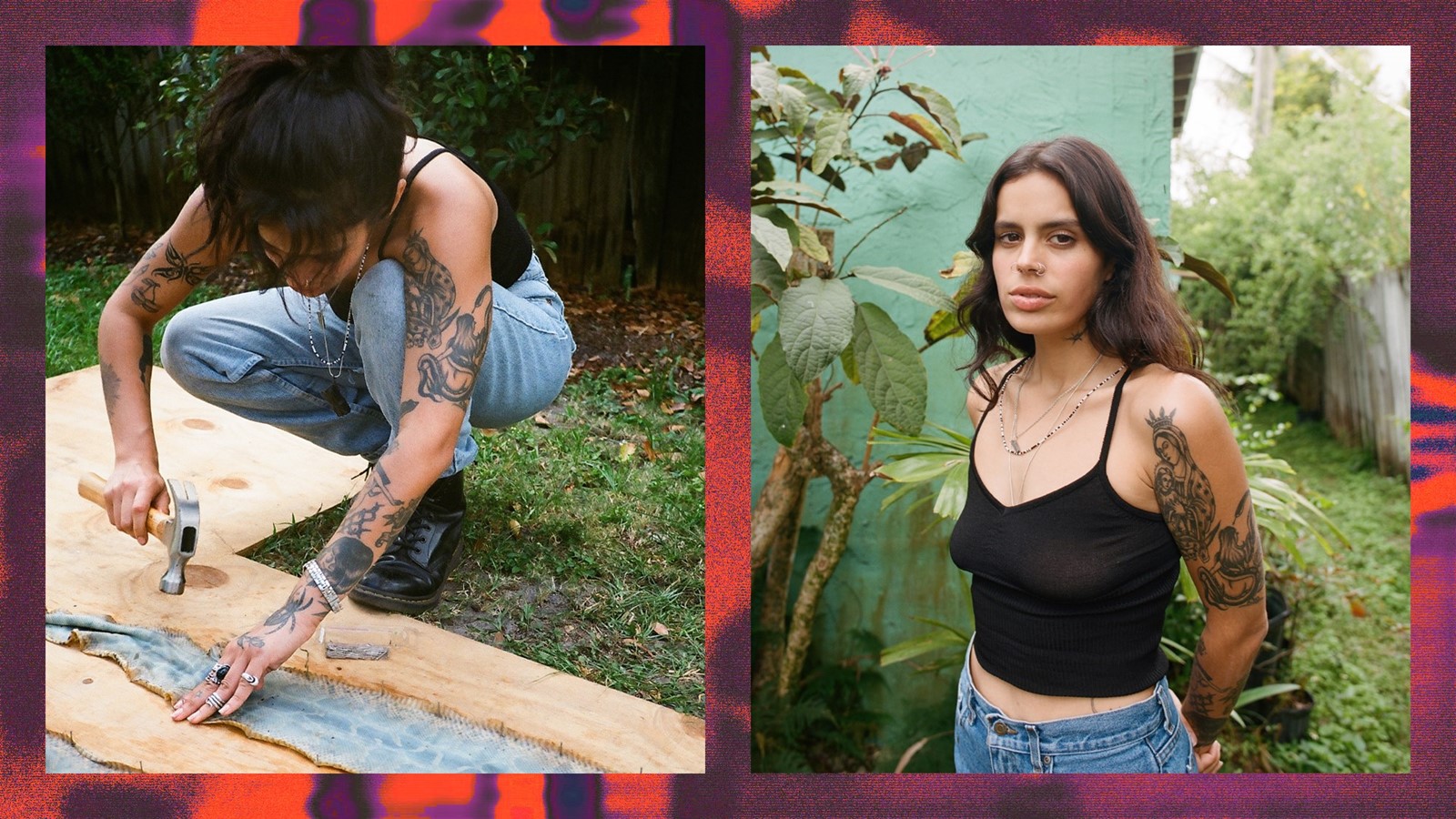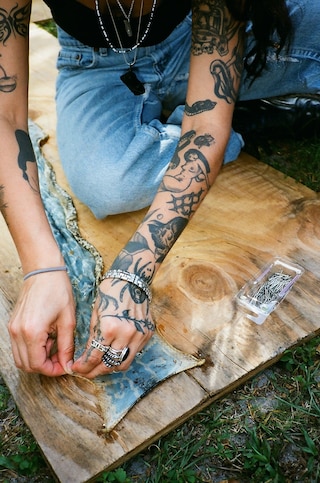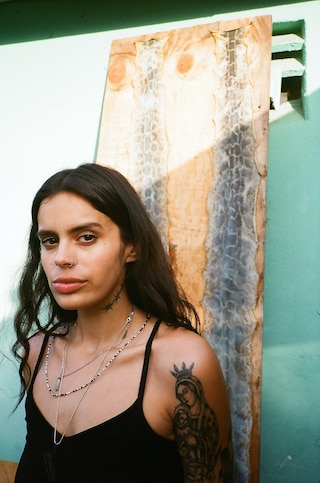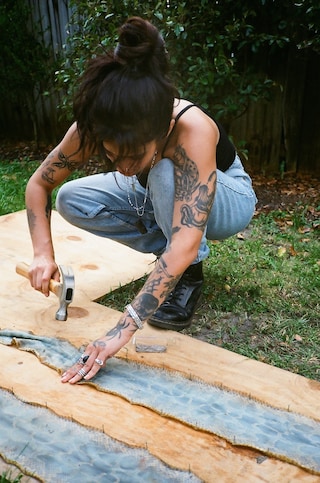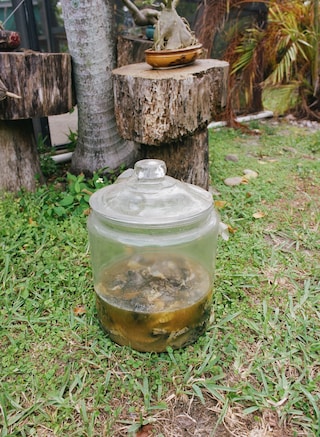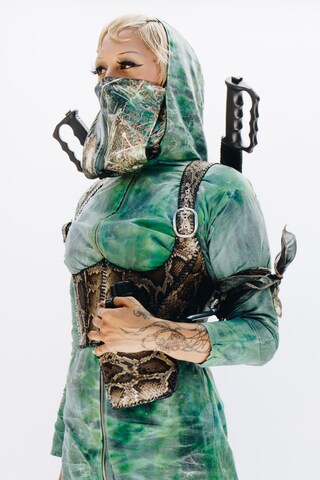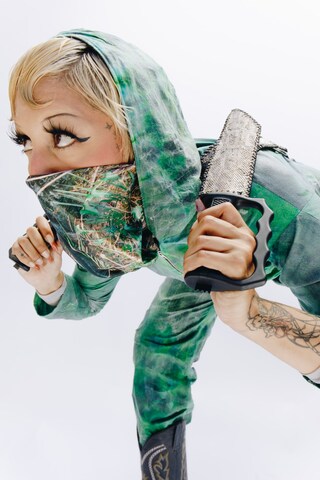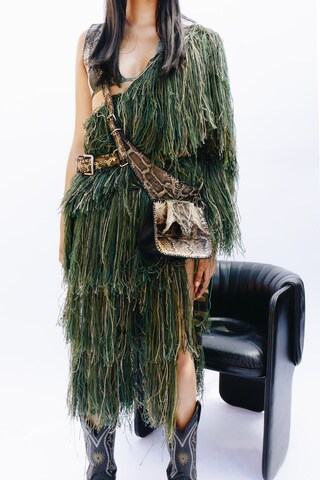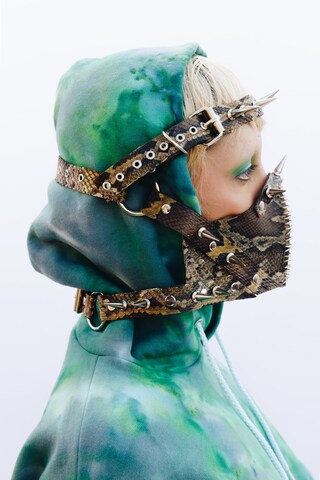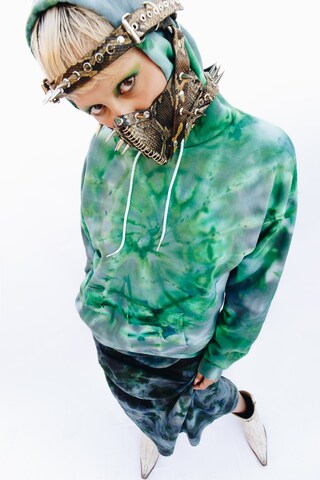With the state employing hunters to reduce the population, former Yeezy assistant Elle Barbeito went back to her roots to craft snake-skin fashion in the Everglades
Welcome to A Future World – Dazed's network, community, and platform focusing on the intersection of science, technology and pop culture. Throughout April, we're featuring conversations and mission statements from the people paving new pathways for our planet: activists, inventors, fashion pioneers, technologists, AI scientists, and global youth movements, alongside in-depth editorial exploring the new realities for our future world.
The Burmese python, a snake native to Southeast Asia and currently undulating rapidly across the Florida Everglades, is beautiful – objectively, unsentimentally beautiful. Close your eyes and imagine any snake at all: even if you’ve never seen one in person, the Burmese python likely occupies your imagination – it’s an archetypal snake, graceful and massive, blazoned with oil-smooth markings that form terraneous patterns, like dark map lines or puzzle pieces. One of the world’s largest snakes, Burmese pythons grow long – up to 23 feet – and wide; in the humidity of the Everglades, a climate not unlike their countries of origin, they have no real predators, not even the Florida gator.
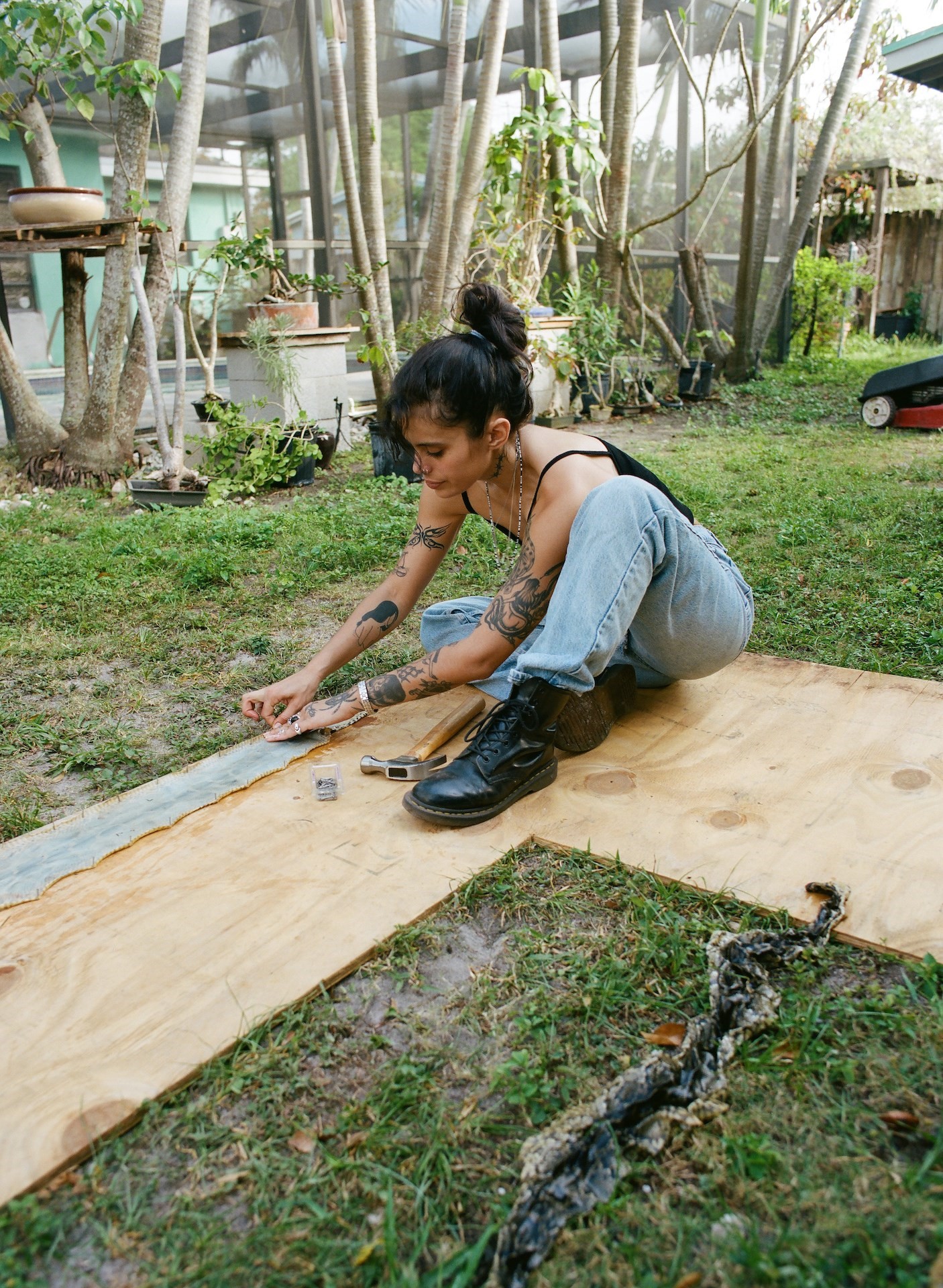
Much wildlife can adapt happily and safely to new environments, and using terms like “non-native” and “invasive” around introduced flora and fauna can be dangerous, militarized, and inaccurate. That said, Florida has more introduced species, particularly reptiles, than any other state, due in part to pet-owners (in February, the state’s Fish and Wildlife Conservation Commission, aka FWC, banned the possession and breeding of certain non-native reptiles for their adverse effects on local habitats).
The Burmese python might be the most infamous. As Florida endures the effects of climate change – rising temperatures, decreasing biodiversity, seawater creeping through the state’s porous limestone bedrock – the python thrives, moving northerly. Studies are conflicting: some argue that Burmese pythons are unable to survive the cold snaps north of South Florida; others find some can adapt, quickly. They remain enigmatic and easily camouflaged, their precise population unknown. Through agencies like the South Florida’s Water Management District (SFWMD) and the FWC – and more volunteer independent projects, like the Swamp Apes – hunters are employed to slowly eradicate the population.
“The first time we went to the Everglades during the day,” says Elle Barbeito. “It was so beautiful, so quiet. The air just felt better. I expected to feel more scared because the experience is intense, but it was a moment of great excitement and curiosity. I had never seen the Everglades in that light. I felt extremely lucky to be able to interact with the snakes in this way, and grateful they were there to help me create and make the things I do.”
“I felt extremely lucky to be able to interact with the snakes in this way, and grateful they were there to help me create and make the things I do” – Elle Barbeito
Barbeito, a Miami-born multidisciplinary artist and designer, is describing the feeling of hunting the Burmese python with her father, Mark Yon; she has accompanied him on python-hunting excursions for the last four years, incorporating the snakes’ marbled skin into her work for nearly as many. Her objects – camouflaged hoods, corsets, tool bags, sheaths – assimilate the python not only in form but in spirit, too; they’re purposeful responses to the exigencies of the swamp. Nearly all of South Florida was once the Everglades – a slow-flowing river of ecosystems beginning around the center of the state and moving south, previously home to the Miccosukee and the Seminole – though its flows and biorhythms were diverted by the Army Corp of Engineers to make way for agricultural production. Overdevelopment continues to poison the water; waters continue to rise. Barbeito’s practice addresses the notion of ongoing life in the region: adapting to the cadence of the Everglades, clad in the colors of its landscapes.
Barbeito, who is also a painter and photographer, discovered fashion design serendipitously, during a high school woodworking class: “Everything I was building was meant to be worn – I wasn’t even doing it on purpose.” She began designing independently and, in 2020, worked as a design assistant for Yeezy’s Season 8 collection, utilizing her skills in handwork. Years ago, she was studying fashion design at Pratt when she received a text from her father: he was hunting snakes in the Everglades with his friend Brian Hargrove, a python hunter for the SFWMD, and did she want to join? At the time, Barbeito felt disillusioned by the wastefulness of the fashion industry, the relentless pace of the city. “Moving back home was already in the works for me,” she says. “I loved New York, but it was draining.”
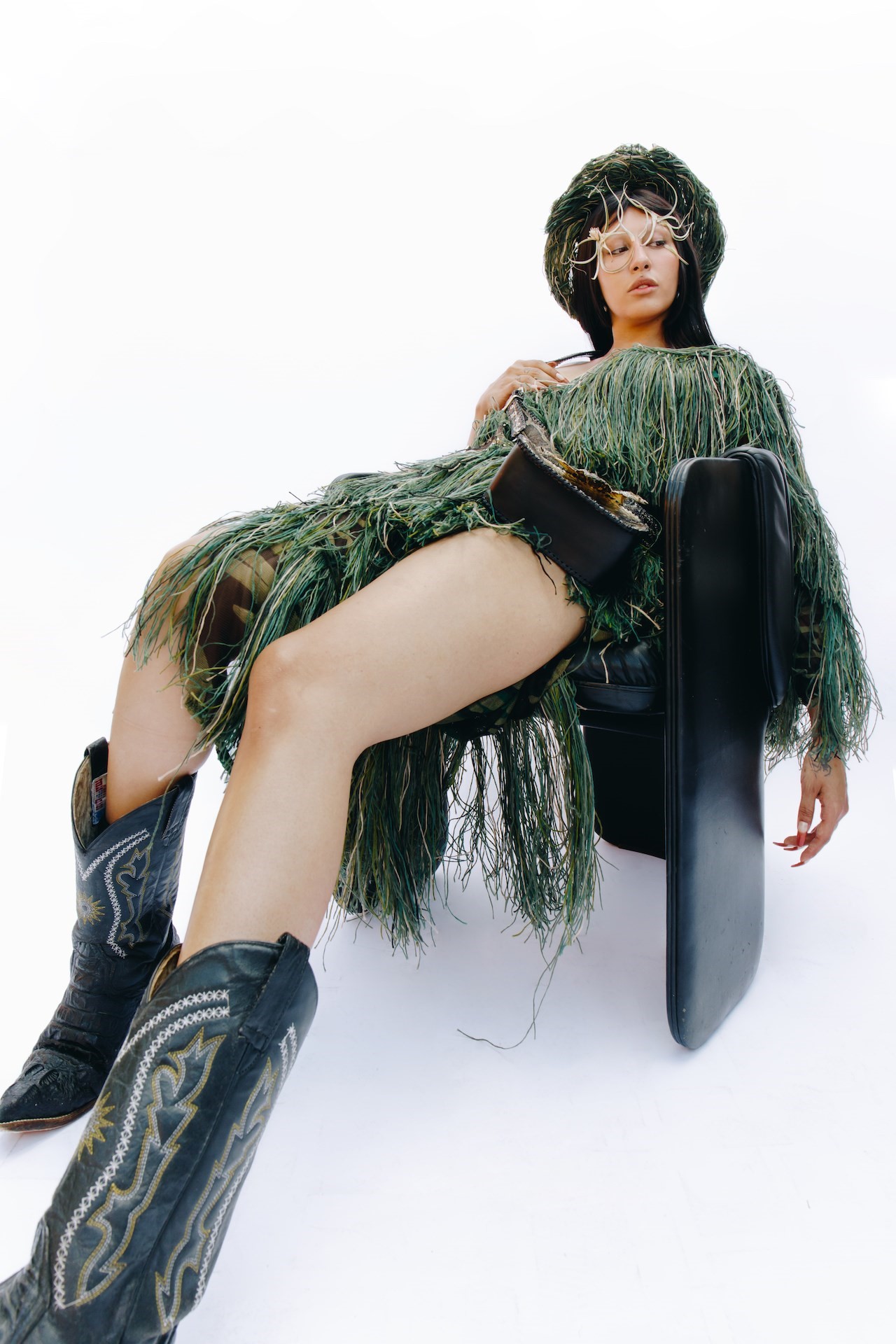
In Florida, she felt newly reinvigorated by the warmth and peace, at first observantly tagging along on her father’s excursions. “It’s genuinely relaxing out there. While hunting is part of my dad’s job, being in the Everglades still felt like a way to disconnect from everything,” she says. “I felt the transition – I used to occasionally visit, but now the land was becoming part of my work, my daily life.” Barbeito’s father most often ventures out at night, typically sticking to one or two routes; they shine flashlights and headlamps out the windows of Hargrove’s truck till they spot movement, then jump out to chase and grab the snake by hand. “When they see it, they catch it—but if I see it, I have to catch it myself.”
Here, she found an unexpected new medium. “My dad told me he’d started skinning them and storing them,” she explains. “He says, ‘I’m not going to have Mother Earth pissed off at me for not honoring this snake’s life and using every single part of it.’” Barbeito wondered: “‘Can you make stuff with the skin?’ I’d never thought in leather; I was mostly working with woven design and ready-to-wear. Because of the python skin, I got into it – brainstorming, researching. It was a lot of (watching) YouTube videos, puzzling different pieces together.”
After skinning the snakes, Barbeito stores the skins in a mix of glycerin and alcohol – and sometimes Florida water – allowing them to treat for at least two weeks. When they’re ready, she stretches and nails them along planks of wood, where they’ll dehydrate in the sun for a week or more. The liquid has turned, by now, into an elixir she calls “forbidden kombucha”; the stench of the skin is fishy, funky, almost sour. After the skins are dry, they’re surprisingly pliable; Barbeito sometimes attaches them to other leathers, hardening them.
So long as the snakes’ eradication is still necessitated by the state, Burmese python leather is plainly sustainable. Through her new discovery, Barbeito learned to love leather. “It’s supposed to be durable,” she says. “It’s made to last longer than your life; you can pass it on to your children. That means less items are being made. It comes from animals, but as long as people are eating meat in America, leather will continue to be a byproduct of that industry.” There is little to no waste in her process, nor any plastic, and Barbeito never tosses extra scraps. “I keep all of them. I want to be as intentional as possible – I don’t want to keep adding to a problem.”
“My dad says, ‘I’m not going to have Mother Earth pissed off at me for not honoring this snake’s life and using every single part of it.’ (I thought) ‘Can you make stuff with the skin?’” – Elle Barbeito
Barbeito also doesn’t want to reiterate the medium’s typical uses: though she’d initially experimented with chokers and harnesses, she did away with them. Instead, she began designing “things I need for myself – because more than likely, other people need them, too.” Her new collection, #0021, includes a piece inspired by the Ghillie suit, a Scotland-derived camouflage tactical outfit; a dissembling mask screen-printed with a grass-and-python-skin image she snapped herself; a python-skin corset, complete with knife sheaths.
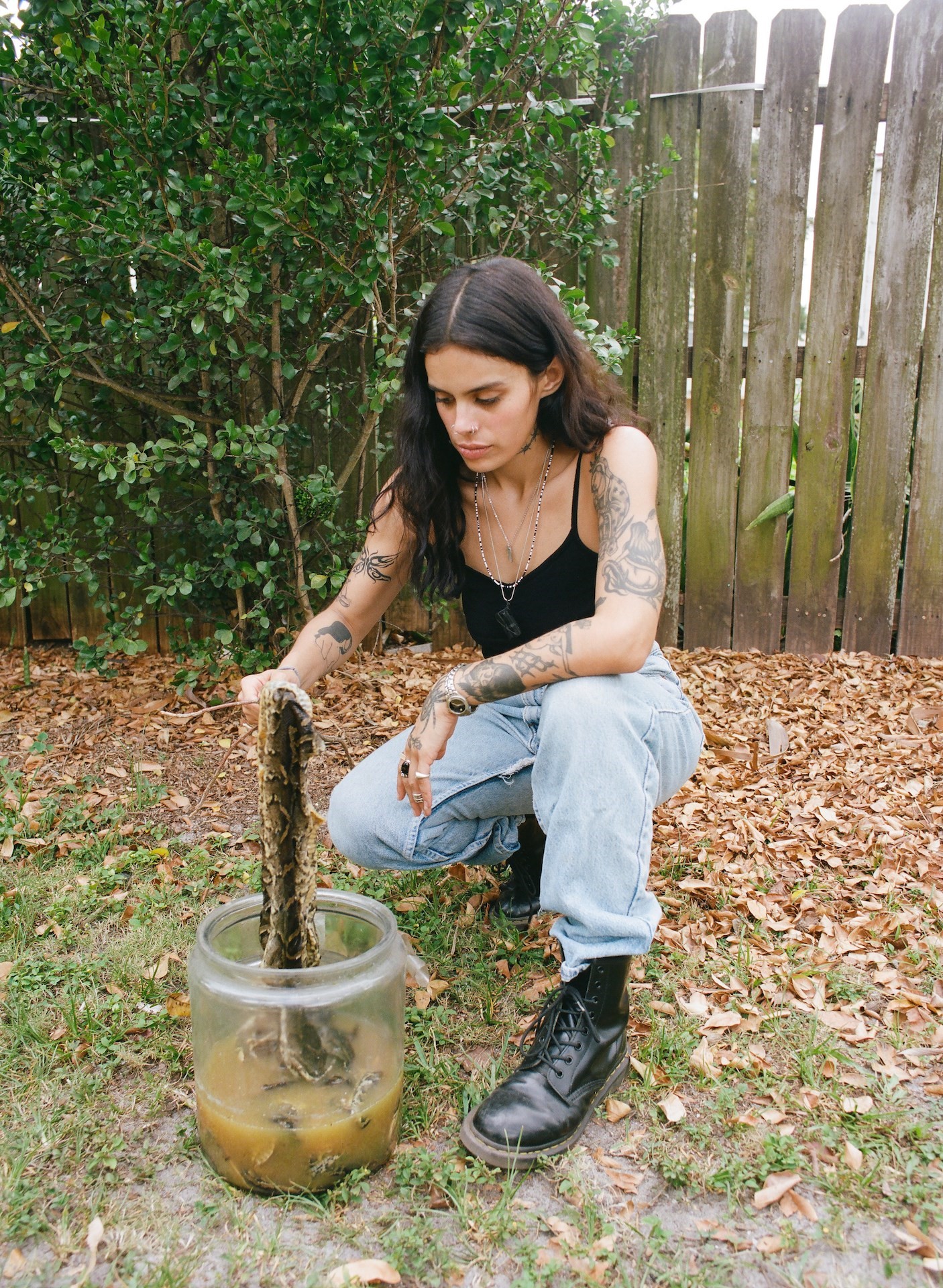
The collection’s four looks are utilitarian when worn amid the marshy terrains of Florida, sleek and functional everywhere else. “Hunting guys—that kind of culture—influences my work a lot,” says Barbeito. “It’s very relevant to Florida: camouflaging into what we’ve always known.”
“Florida is the South,” she continues, “but not in the same way other states are. The South I grew up with was fishing, Cuban dudes, cigars, coffee.” (Barbeito is Cuban and Chilean herself.) There’s a femme, swamp-cowboy-inspired, distinctly Florida flashiness coursing through each item; you’ll see it in the fishhook-like handle of a tool bag, the alligator print on a shirt, the python skin, everywhere.
How did the Burmese python get here? It’s mostly land-occupying humans – arguably the world’s most invasive species – that are at fault. First spotted in the Everglades in October 1979, the Burmese python was part of the American exotic pet trade, for which Miami was the hub; owners often released the animals when they grew too large. It’s speculated the population grew significantly in 1992, after Hurricane Andrew, a Category-5 storm, destroyed a breeding facility, sending large numbers of pythons into the wild. Though nonpoisonous, the snakes are dietary generalists, meaning they’ll eat almost anything: a 2012 study revealed that the number of raccoons and possums in the Everglades National Park had declined by almost 99%, with bobcat and marsh rabbit populations close behind. Today, the Burmese python is slowly eating away at the Everglades’ birds.
There is a deep need for all Floridians to understand the Everglades: their waters, their history, their inextricability from the state’s Indigenous communities—especially as the land continues to reflect the pain of occupation, pollution, and climate change. In a 2018 video for the Associated Press, Hargrove, the python hunter with whom Barbeito and her father work, reflects with a kind of sadness: “It’s a beautiful creature. It’s not their fault.” A troublesome industry is responsible for the Burmese python’s arrival in Miami; Barbeito understands the complexity of utilizing such an animal to address the inherent wastefulness of another, equally problematic industry. But in Florida, python leather leaves little footprint; indeed, the end result might be a more healthful ecosystem. Even Barbeito, a Florida native, is still getting to know the Everglades, its many non-human inhabitants, and the potentially healing ways to work with its ecosystem. “There’s still a lot of curiosity and nervousness,” she says. “I’m still learning. I feel it’s better to approach things with that kind of attitude—that kind of warmth. You’re spending time with it. It’s a relationship.”
